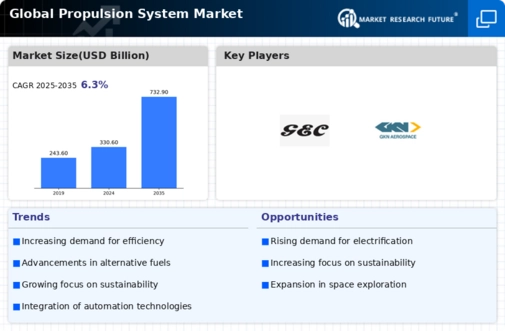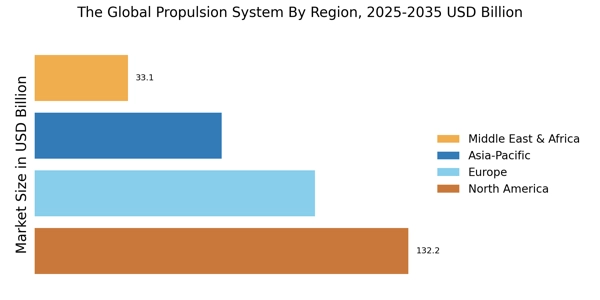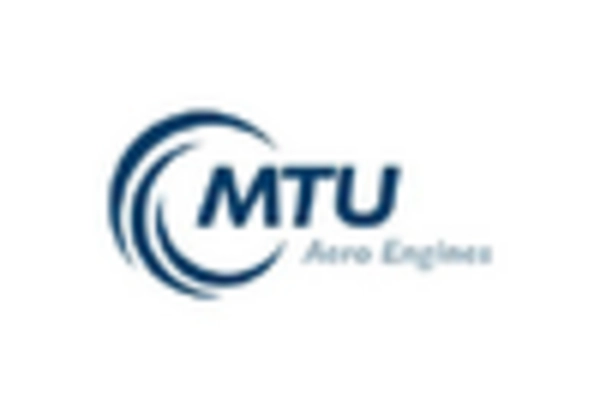Growth in Defense Expenditure
The increase in defense expenditure across various nations is a notable driver for The Global Propulsion System Industry. Governments are investing heavily in modernizing their military capabilities, which includes upgrading propulsion systems for aircraft, naval vessels, and ground vehicles. This trend is particularly evident in regions experiencing geopolitical tensions, where defense budgets are being expanded to enhance national security. According to recent reports, global military spending is projected to reach unprecedented levels, with a significant portion allocated to advanced propulsion technologies. This surge in defense spending not only stimulates demand for innovative propulsion systems but also fosters collaboration between defense contractors and technology providers, thereby driving market growth.
Government Initiatives and Regulations
Government initiatives and regulations aimed at reducing carbon emissions are significantly impacting The Global Propulsion System Industry. Various countries are implementing stringent environmental regulations that require the aviation and maritime sectors to adopt cleaner propulsion technologies. For instance, initiatives promoting the use of sustainable aviation fuels and electric propulsion systems are gaining momentum. These regulatory frameworks not only encourage innovation but also provide financial incentives for companies investing in cleaner technologies. As a result, manufacturers are increasingly focusing on developing propulsion systems that comply with these regulations, thereby enhancing their market competitiveness and contributing to the overall growth of the industry.
Emergence of Space Exploration Initiatives
The emergence of space exploration initiatives is reshaping the landscape of The Global Propulsion System Industry. With both governmental and private entities investing in space missions, the demand for advanced propulsion systems is on the rise. Notable projects, such as Mars exploration missions and satellite deployment, require cutting-edge propulsion technologies to ensure mission success. The commercial space sector is also witnessing rapid growth, with companies aiming to provide launch services and space tourism. This burgeoning interest in space exploration is expected to drive innovation in propulsion systems, leading to the development of more efficient and powerful engines. As a result, the market is likely to experience substantial growth, fueled by the increasing number of space missions planned for the coming years.
Increasing Demand for Aerospace Applications
The rising demand for aerospace applications is a crucial factor influencing The Global Propulsion System Industry. As air travel continues to expand, the need for efficient and reliable propulsion systems becomes paramount. The commercial aviation sector is expected to witness a substantial increase in aircraft deliveries, with projections indicating a demand for over 40,000 new aircraft in the next two decades. This surge in demand necessitates advancements in propulsion technologies to enhance fuel efficiency and reduce operational costs. Furthermore, the growing interest in urban air mobility and unmanned aerial vehicles is likely to create new opportunities for propulsion system manufacturers, thereby driving market growth.
Technological Advancements in Propulsion Systems
The ongoing technological advancements in propulsion systems are a primary driver for The Global Propulsion System Industry. Innovations such as electric and hybrid propulsion technologies are gaining traction, offering enhanced efficiency and reduced emissions. The integration of advanced materials and manufacturing techniques is also contributing to the development of lighter and more efficient propulsion systems. According to recent data, the market for electric propulsion systems is projected to grow significantly, with estimates suggesting a compound annual growth rate of over 15% in the coming years. This shift towards more sophisticated technologies not only improves performance but also aligns with global sustainability goals, thereby attracting investments and fostering growth within the industry.


















Leave a Comment